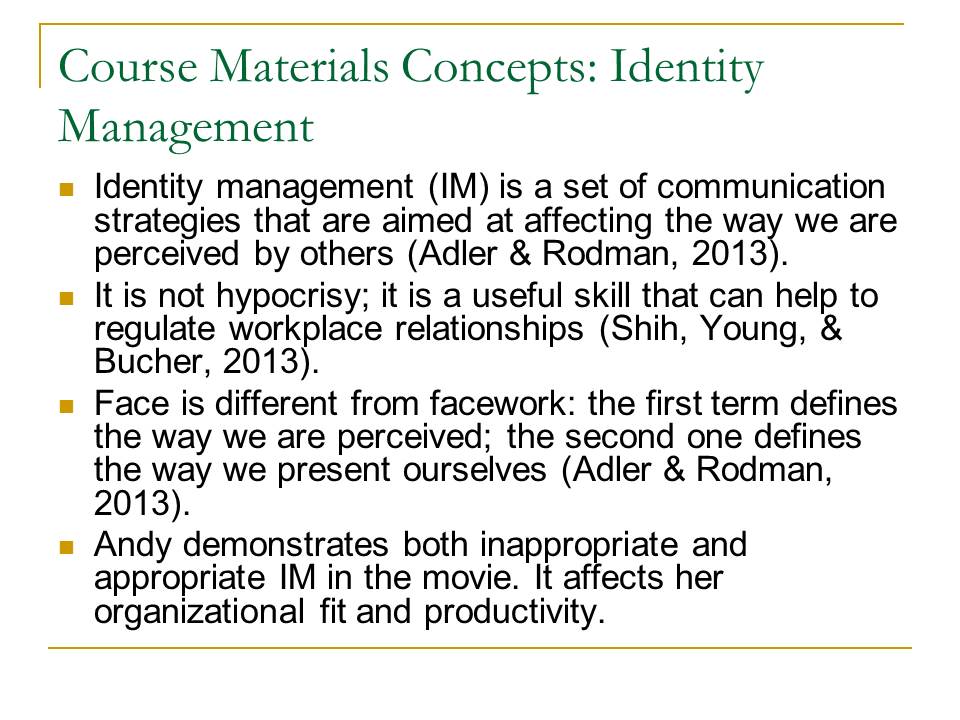The presentation is devoted to the identity management of Andy, a character from the film Devil Wears Prada by Finerman and Frankel (2006).
Background Information
- The movie is based on Lauren Weisberger’s novel of the same name; messages are different for the two works (Scott, 2014).
- The plot: the dynamics of the relationships between a new employee (Anne Hathaway as Andy), her employer (Meryl Streep as Miranda), and other employees.
- Miranda is an authoritative leader (Runway magazine editor), does not seek to empower employees, manipulates, and deliberately inspires fear. The movie does not portray her as a one-dimensional villain.
- Andy is recently graduated, which defines her initial ineptitude; she finds it difficult to fit, which is partially her responsibility. Miranda does not help, though.
The movie is based on Lauren Weisberger’s novel of the same name, but the message was changed in the movie (Scott, 2014). Both works are about the dynamics of the relationships between a new employee (Anne Hathaway as Andy), her employer (Meryl Streep as Miranda), and other employees. Also, both works show Miranda as a manipulative and authoritative leader who does not seek to empower employees and works to inspire fear. However, unlike the book, the movie does not portray her as a one-dimensional villain. Andy, the “victim,” is a recently graduated journalist, which defines her initial troubles: she has difficulties with the work and also experiences issues with organizational fit. Unfortunately, she is partially responsible for them.

Course Materials Concepts: Identity Management
- Identity management (IM) is a set of communication strategies that are aimed at affecting the way we are perceived by others (Adler & Rodman, 2013).
- It is not hypocrisy; it is a useful skill that can help to regulate workplace relationships (Shih, Young, & Bucher, 2013).
- Face is different from facework: the first term defines the way we are perceived; the second one defines the way we present ourselves (Adler & Rodman, 2013).
- Andy demonstrates both inappropriate and appropriate IM in the movie. It affects her organizational fit and productivity.
Identity management is a set of communication strategies that are used to affect the way in which we are perceived by others. Adler and Rodman (2013) specifically point out that it is not hypocrisy; it is a communication tool that helps people to be more effective in the different roles that they play. Similarly, Shih, Young, and Bucher (2013) demonstrate how identity management can improve workplace relationships and even help to avoid discrimination. Identity management is correlated with the terms “face” and “facework.” “Face” defines the way we are perceived; “facework” is the way we present ourselves (Adler & Rodman, 2013). In the film, Andy demonstrates both inappropriate and appropriate identity management, which affects her organizational fit and productivity.

The Movie: Concept Application
- This facework shows incompetence (she is working at the fashion industry) and communicates no wish to fit. The face that Miranda sees leaves her dissatisfied.
- This facework shows that she has taste, knows about fashion, wishes to fit in the industry. Miranda likes this face, and it becomes easier for Andy to fit in.
Now we will apply this theory to practice. At the beginning, Andy deliberately chooses to ignore fashion principles as she believes that the fashion industry is superficial. In other words, she chooses to communicate the message that she does not fit into the company and does not want to. The difficulties in the organizational fit follow quite logically, and they are not the fault of Miranda’s character: it is her natural reaction to such a non-verbal message. Also, Andy accidentally translates her incompetence in the sphere, which further dissatisfies Miranda. When Nigel convinces Andy to change her facework, it helps her to eliminate the harmful messages that she was initially translating, and as a result, Miranda becomes more well-disposed towards Andy.

Conclusions. Learning Outcome
The following conclusions can be made:
- Andy’s organizational fit depended on her IM, which was based on nonverbal communication.
- IM was the turning point of the development of Andy’s relationship with Miranda; it can be claimed to be one of the main communication themes.
- Organizational fit might require efforts from the person.
- The following outcomes were met in the course of the work.
- Learning Outcome 1: concepts familiarity, relating course materials to various settings, research, computer applications use.
- Learning Outcome 3: communicate findings.
The movie demonstrates the importance of identity management: Andy’s organizational fit literally depended on it, and her new facework became the turning point for the development of her relationships with Miranda. It can be concluded that without this identity management, which was primarily nonverbal, the relationship could not progress, and, therefore, it can be claimed to be one of the main communication themes in the movie. Also, the movie demonstrates that organizational fit might require some efforts from the person: at the very least, he or she should not communicate the wish to “not fit.”
In this PowerPoint presentation, the use of computer application was aimed at communicating the insights that the relation of the class materials to non-classroom settings has produced. Therefore, this work appears to relate primarily to the Learning Outcome 1 (especially to its second and fifth parts) and Learning Outcome 3 (especially its first point). However, the First Outcome appears to be the primary one for this assignment.

References
Adler, R. & Rodman, G. (2013). Understanding human communication (12th ed.). New York, NY: Oxford University Press.
Finerman, W. (Producer), & Frankel, D. (Director). (2006). The Devil Wears Prada [Motion picture]. United States: Fox 2000 Pictures.
Scott, A. O. (2014). In ‘The Devil Wears Prada,’ Meryl Streep plays the terror of the fashion world. The New York Times. Web.
Shih, M., Young, M., & Bucher, A. (2013). Working to reduce the effects of discrimination: Identity management strategies in organizations. American Psychologist, 68(3), 145-157. Web.